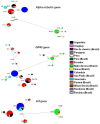Genus paracoccidioides: Species recognition and biogeographic aspects
- PMID: 22666382
- PMCID: PMC3364295
- DOI: 10.1371/journal.pone.0037694
Genus paracoccidioides: Species recognition and biogeographic aspects
Abstract
Background: Paracoccidioidomycosis is a systemic mycosis caused by Paracoccidioides brasiliensis (species S1, PS2, PS3), and Paracoccidioides lutzii. This work aimed to differentiate species within the genus Paracoccidioides, without applying multilocus sequencing, as well as to obtain knowledge of the possible speciation processes.
Methodology/principal findings: Single nucleotide polymorphism analysis on GP43, ARF and PRP8 intein genes successfully distinguished isolates into four different species. Morphological evaluation indicated that elongated conidia were observed exclusively in P. lutzii isolates, while all other species (S1, PS2 and PS3) were indistinguishable. To evaluate the biogeographic events that led to the current geographic distribution of Paracoccidioides species and their sister species, Nested Clade and Likelihood Analysis of Geographic Range Evolution (LAGRANGE) analyses were applied. The radiation of Paracoccidioides started in northwest South America, around 11-32 million years ago, as calculated on the basis of ARF substitution rate, in the BEAST program. Vicariance was responsible for the divergence among S1, PS2 and P. lutzii and a recent dispersal generated the PS3 species, restricted to Colombia. Taking into account the ancestral areas revealed by the LAGRANGE analysis and the major geographic distribution of L. loboi in the Amazon basin, a region strongly affected by the Andes uplift and marine incursions in the Cenozoic era, we also speculate about the effect of these geological events on the vicariance between Paracoccidioides and L. loboi.
Conclusions/significance: The use of at least 3 SNPs, but not morphological criteria, as markers allows us to distinguish among the four cryptic species of the genus Paracoccidioides. The work also presents a biogeographic study speculating on how these species might have diverged in South America, thus contributing to elucidating evolutionary aspects of the genus Paracoccidioides.
Conflict of interest statement
Figures




References
-
- Untereiner WA, Scott JA, Naveau FA, Sigler L, Bachewish J, et al. The Ajellomycetaceae, a new family of vertebrate-associate Onygenales. Mycol. 2004;96(4):812–821. - PubMed
-
- Franco M. Host-parasite relationships in Paracoccidioidomycosis. J Med Vet Mycol. 1987;25:5–18. - PubMed
-
- McEwen JG, Bedoya V, Patino MM, Salazar ME, Restrepo A. Experimental murine Paracoccidioidomycosis induced by the inhalation of conidia. J Med Vet Mycol. 1987;25:165–175. - PubMed
-
- Bagagli E, Bosco SMG, Theodoro RC, Franco M. Phylogenetic and evolutionary aspects of Paracoccidioides brasiliensis reveal a long coexistence with animal hosts that explain several biological features of the pathogen. Infect Genet Evol. 2006;6:344–351. - PubMed
Publication types
MeSH terms
Substances
LinkOut - more resources
Full Text Sources

